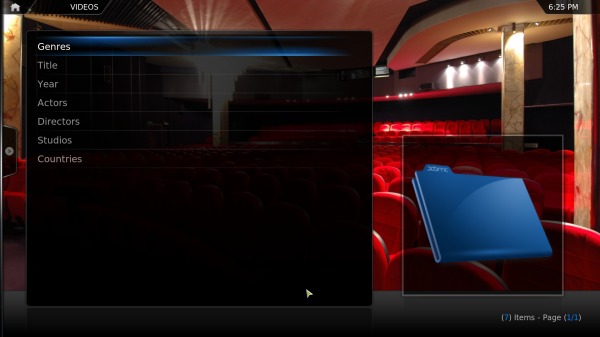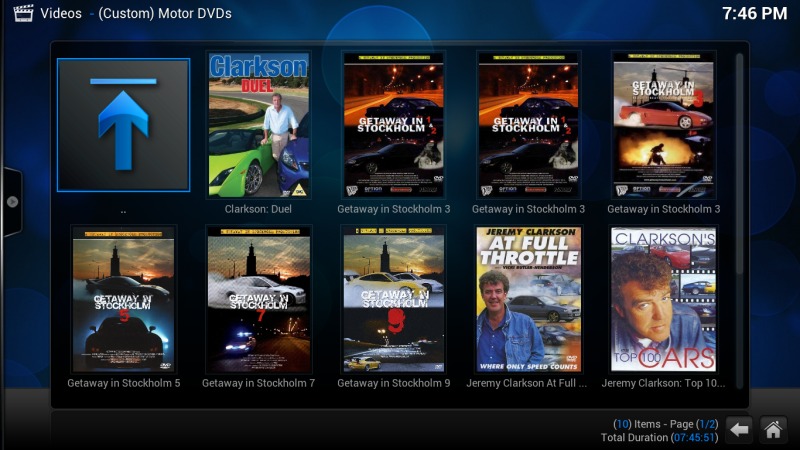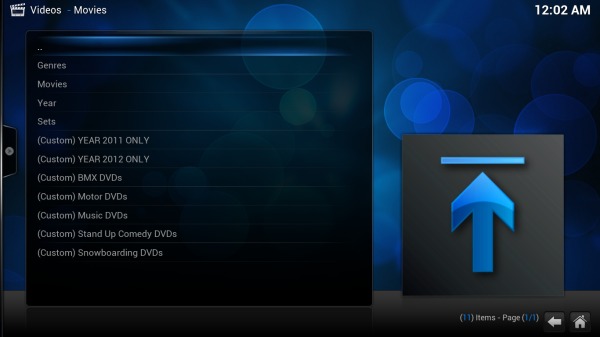Video nodes: Difference between revisions
>Sho |
>Charliek No edit summary |
||
| Line 4: | Line 4: | ||
As of the latest post Eden Nightly builds, XBMC introduces the ability to customize these nodes using an XML file. Using XML files really gives great flexibility in how you display your media. Don't want your screaming kids stuff in your main movie node... exclude it. Want documentaries in a separate node, create it. Don't like how recently added is presented, change it. | As of the latest post Eden Nightly builds, XBMC introduces the ability to customize these nodes using an XML file. Using XML files really gives great flexibility in how you display your media. Don't want your screaming kids stuff in your main movie node... exclude it. Want documentaries in a separate node, create it. Don't like how recently added is presented, change it. | ||
NOTE: Just to repeat this feature is not available in the latest stable Eden release. You will have to install one of the nightly builds to test it. | NOTE: Just to repeat this feature is not available in the latest stable Eden release. You will have to install one of the nightly builds to test it. To get full functionality from custom nodes, you need to use a skin that allows you to deploy them as you would like (e.g. latest builds of Aeon Nox). Confluence will show your nodes, but doesn't allow you to decide exactly where. | ||
==The default Nodes== | ==The default Nodes== | ||
To understand this a little better, lets take a look at one of the default nodes. You can find these in: | To understand this a little better, lets take a look at one of the default nodes. You can find these in the application's main filesystem (as opposed to the user profile tree, which is where we'll be creating our custom nodes later): | ||
Under Windows (32bit) default install, they are in "''C:\Program Files\XBMC\system\library\video\movies''" | |||
Under Windows (64bit) default install, they are in "''C:\Program Files (x86)\XBMC\system\library\video\movies''" | |||
and under linux, they are in "''usr/share/xbmc/system/library/video/movies''" (? verify) | |||
As an example lets take a quick look at the ''years.xml'' node in its simplest form: | |||
<node order="3" type="folder"> | <node order="3" type="folder"> | ||
| Line 37: | Line 41: | ||
==Creating a Custom node== | ==Creating a Custom node== | ||
So now we understand how the default nodes work, lets have a look at making a custom node. | So now we understand how the default nodes work, lets have a look at making a custom node. Custom nodes live in the user profile tree, in Frodo Beta 1 they would go in ''[...]\userdata\Database'', in more recent builds, they go in the ''[...]\userdata\library'' directory: | ||
Under Windows: ''%appdata%\XBMC\userdata\library'' | |||
Under Linux: ''$HOME/.xbmc/userdata/library'' | |||
(Note, under Windows %appdata% is a variable for the user application data directory. So the above is a shortcut for something that looks like ''C:\Users\joe\AppData\Roaming\XBMC\userdata\library'') | |||
To create custom nodes, the first step is to copy the whole of the default node filestructure to your userdata library. | |||
So, in the case of windows, copy the 'video' and the 'video_flat' folders from ''C:\Program Files (x86)\XBMC\system\library'' to ''%appdata%\XBMC\userdata\library''. | |||
Why the whole lot? Well, currently it seems that when you have a custom video node in your userdata folder, it's assumed that you are customising the node structure, and that therefore any nodes that are missing are missing intentionally. | |||
Having copied the node structure, we can now create a new xml file under the relevant directory. | |||
In a vanilla install with the confluence skin, custom nodes in ''/video'' will appear in the sub-list of the Video main menu item. | |||
Custom nodes in the ''/video/movies'' will appear in the sub-list of 'Movies' which in turn appears in the sub-list of Video. NOTE: it will not appear in the sub-list of 'Movies' as, in the confluence skin at least, this is set to list all the video source content marked as 'movies'. | |||
In other skins (notably, Aeon Nox), custom main-menu items can be set to a custom video node, meaning that you can use your custom video nodes to have a main-menu item for your collection of post-modern european arthouse anime, if you so wish. | |||
For now, we're going to place our node under | |||
/userdata/library/video/ | /userdata/library/video/ | ||
Revision as of 20:07, 21 November 2012
Template:XBMC wiki tocTemplate:Frodo Nodes are defined views that are used to organize your media from the videos menu. In the past XBMC has had a number of standard nodes such as Title, Director, Year, Studios, Countries, Genres that were hard coded.
As of the latest post Eden Nightly builds, XBMC introduces the ability to customize these nodes using an XML file. Using XML files really gives great flexibility in how you display your media. Don't want your screaming kids stuff in your main movie node... exclude it. Want documentaries in a separate node, create it. Don't like how recently added is presented, change it.
NOTE: Just to repeat this feature is not available in the latest stable Eden release. You will have to install one of the nightly builds to test it. To get full functionality from custom nodes, you need to use a skin that allows you to deploy them as you would like (e.g. latest builds of Aeon Nox). Confluence will show your nodes, but doesn't allow you to decide exactly where.
The default Nodes
To understand this a little better, lets take a look at one of the default nodes. You can find these in the application's main filesystem (as opposed to the user profile tree, which is where we'll be creating our custom nodes later):
Under Windows (32bit) default install, they are in "C:\Program Files\XBMC\system\library\video\movies"
Under Windows (64bit) default install, they are in "C:\Program Files (x86)\XBMC\system\library\video\movies"
and under linux, they are in "usr/share/xbmc/system/library/video/movies" (? verify)
As an example lets take a quick look at the years.xml node in its simplest form:
<node order="3" type="folder"> <label>562</label> <path>videodb://1/3</path> <icon>DefaultYear.png</icon> </node>
As you can see we are using standard xml format here so nothing too complicated.
(The standard XBMC video nodes)
XML node components
Order = This is the order that you want to show the nodes. Starts at 1 for the top and goes sequentially so 2 will be the next node down.
Label = This is the text that will show for the node. In this case it is pointing to an ID in the strings.xml file (for transltion purposes) It can also just be any String you want, just type some text instead of the id number.
Path = This can be any valid XBMC path
Icon = Pretty self explanatory really, this is the icon that will show when the node is navigated over
Creating a Custom node
So now we understand how the default nodes work, lets have a look at making a custom node. Custom nodes live in the user profile tree, in Frodo Beta 1 they would go in [...]\userdata\Database, in more recent builds, they go in the [...]\userdata\library directory:
Under Windows: %appdata%\XBMC\userdata\library
Under Linux: $HOME/.xbmc/userdata/library
(Note, under Windows %appdata% is a variable for the user application data directory. So the above is a shortcut for something that looks like C:\Users\joe\AppData\Roaming\XBMC\userdata\library)
To create custom nodes, the first step is to copy the whole of the default node filestructure to your userdata library.
So, in the case of windows, copy the 'video' and the 'video_flat' folders from C:\Program Files (x86)\XBMC\system\library to %appdata%\XBMC\userdata\library.
Why the whole lot? Well, currently it seems that when you have a custom video node in your userdata folder, it's assumed that you are customising the node structure, and that therefore any nodes that are missing are missing intentionally.
Having copied the node structure, we can now create a new xml file under the relevant directory.
In a vanilla install with the confluence skin, custom nodes in /video will appear in the sub-list of the Video main menu item.
Custom nodes in the /video/movies will appear in the sub-list of 'Movies' which in turn appears in the sub-list of Video. NOTE: it will not appear in the sub-list of 'Movies' as, in the confluence skin at least, this is set to list all the video source content marked as 'movies'.
In other skins (notably, Aeon Nox), custom main-menu items can be set to a custom video node, meaning that you can use your custom video nodes to have a main-menu item for your collection of post-modern european arthouse anime, if you so wish.
For now, we're going to place our node under
/userdata/library/video/
Let's call it Custom_Motor_dvds.xml
<node order="10" type="filter"> <label>(Custom) Motor DVDs</label> <path>videodb://1/3</path> <content>movies</content> <match>all</match> <icon>DefaultCars.png</icon> <limit>20</limit> <rule field="path" operator="contains">//nas1/Videos/ExtremeSports/Cars</rule> </node>
As you can see as well as changing the order, we have a few more xml tags this time:
Type = Can be Folder or Filter
Match = Specifies how many rules should match. In this case we are matching all rules.
Rule = Any rule created with the smart playlist editor
Limit = Limit the number of results returned
(Custom node in action)
So there you have it, a simple path filter for our Motor DVDs. One thing that you may want to do now is edit your "Title" xml file to remove the motor dvds from the main movie library. You can do this by using the DoesNotContain operator:
<node order="2" type="filter"> <label>Movies</label> <path>videodb://1/3</path> <content>movies</content> <icon>DefaultMovieTitle.png</icon> <match>all</match> <rule field="path" operator="doesnotcontain">//NAS1/Videos/ExtremeSports/Cars/</rule> </node>
There are many other rules you can apply, a simple way to find them is to have a go with the smart playlist editor and copy the rule from the resulting xml playlist. There are many possibilities, you could create a rule for any of the database fields such as genre or year, use paths or combine rules together.
(Various custom video nodes)


